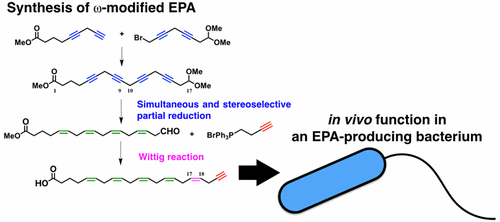当前位置:
X-MOL 学术
›
Bioconjugate Chem.
›
论文详情
Our official English website, www.x-mol.net, welcomes your
feedback! (Note: you will need to create a separate account there.)
Synthesis and Functional Assessment of a Novel Fatty Acid Probe, ω-Ethynyl Eicosapentaenoic Acid Analog, to Analyze the in Vivo Behavior of Eicosapentaenoic Acid
Bioconjugate Chemistry ( IF 4.0 ) Pub Date : 2017-07-24 00:00:00 , DOI: 10.1021/acs.bioconjchem.7b00235 Tomohisa Tokunaga 1 , Bunta Watanabe 1 , Sho Sato 1 , Jun Kawamoto 1 , Tatsuo Kurihara 1
Bioconjugate Chemistry ( IF 4.0 ) Pub Date : 2017-07-24 00:00:00 , DOI: 10.1021/acs.bioconjchem.7b00235 Tomohisa Tokunaga 1 , Bunta Watanabe 1 , Sho Sato 1 , Jun Kawamoto 1 , Tatsuo Kurihara 1
Affiliation

|
Eicosapentaenoic acid (EPA) is an ω-3 polyunsaturated fatty acid that plays various beneficial roles in organisms from bacteria to humans. Although its beneficial physiological functions are well-recognized, a molecular probe that enables the monitoring of its in vivo behavior without abolishing its native functions has not yet been developed. Here, we designed and synthesized an ω-ethynyl EPA analog (eEPA) as a tool for analyzing the in vivo behavior and function of EPA. eEPA has an ω-ethynyl group tag in place of the ω-methyl group of EPA. An ethynyl group has a characteristic Raman signal and can be visualized by Raman scattering microscopy. Moreover, this group can specifically react in situ with azide compounds, such as those with fluorescent group, via click chemistry. In this study, we first synthesized eEPA efficiently based on the following well-known strategies. To introduce four C–C double bonds, a coupling reaction between terminal acetylene and propargylic halide or tosylate was employed, and then, by simultaneous and stereoselective partial hydrogenation with P-2 nickel, the triple bonds were converted to cis double bonds. One double bond and an ω-terminal C–C triple bond were introduced by Wittig reaction with a phosphonium salt harboring an ethynyl group. Then, we evaluated the in vivo function of the resulting probe by using an EPA-producing bacterium, Shewanella livingstonensis Ac10. This cold-adapted bacterium inducibly produces EPA at low temperatures, and the EPA-deficient mutant (ΔEPA) shows growth retardation and abnormal morphology at low temperatures. When eEPA was exogenously supplemented to ΔEPA, eEPA was incorporated into the membrane phospholipids as an acyl chain, and the amount of eEPA was about 5% of the total fatty acids in the membrane, which is comparable to the amount of EPA in the membrane of the parent strain. Notably, by supplementation with eEPA, the growth retardation and abnormal morphology of ΔEPA were almost completely suppressed. These results indicated that eEPA mimics EPA well and is useful for analyzing the in vivo behavior of EPA.
中文翻译:

新型脂肪酸探针ω-乙炔二十碳五烯酸类似物的合成和功能评估,以分析二十碳五烯酸的体内行为
二十碳五烯酸(EPA)是一种ω-3多不饱和脂肪酸,它在从细菌到人类的生物体中扮演着各种有益的角色。尽管其有益的生理功能已被公知,但尚未开发出能够监测其体内行为而不破坏其天然功能的分子探针。在这里,我们设计并合成了ω-乙炔基EPA类似物(eEPA),作为分析EPA体内行为和功能的工具。eEPA具有ω-乙炔基标签代替EPA的ω-甲基。乙炔基具有特征性的拉曼信号,可以通过拉曼散射显微镜观察。此外,该基团可以通过点击化学反应与叠氮化物(例如具有荧光基团的那些)特异性地原位反应。在这项研究中,我们首先根据以下众所周知的策略有效地合成了eEPA。为了引入四个CC双键,使用了末端乙炔与炔丙基卤或甲苯磺酸酯之间的偶联反应,然后通过与P-2镍同时进行立体选择性部分氢化,将三键转化为顺式双键。通过Wittig反应与带有乙炔基的phospho盐引入一个双键和一个ω-末端C-C三键。然后,我们通过使用产生EPA的细菌Shewanella Livingstonensis评估了所得探针的体内功能Ac10。这种适应低温的细菌在低温下可诱导产生EPA,而EPA缺失突变体(ΔEPA)在低温下显示出生长迟缓和异常形态。当eEPA外源补充ΔEPA时,eEPA作为酰基链结合到膜磷脂中,eEPA的量约为膜中总脂肪酸的5%,与EPA膜中的EPA量相当。亲本菌株。值得注意的是,通过补充eEPA,几乎完全抑制了ΔEPA的生长迟缓和异常形态。这些结果表明,eEPA很好地模仿了EPA,可用于分析EPA的体内行为。
更新日期:2017-07-25
中文翻译:

新型脂肪酸探针ω-乙炔二十碳五烯酸类似物的合成和功能评估,以分析二十碳五烯酸的体内行为
二十碳五烯酸(EPA)是一种ω-3多不饱和脂肪酸,它在从细菌到人类的生物体中扮演着各种有益的角色。尽管其有益的生理功能已被公知,但尚未开发出能够监测其体内行为而不破坏其天然功能的分子探针。在这里,我们设计并合成了ω-乙炔基EPA类似物(eEPA),作为分析EPA体内行为和功能的工具。eEPA具有ω-乙炔基标签代替EPA的ω-甲基。乙炔基具有特征性的拉曼信号,可以通过拉曼散射显微镜观察。此外,该基团可以通过点击化学反应与叠氮化物(例如具有荧光基团的那些)特异性地原位反应。在这项研究中,我们首先根据以下众所周知的策略有效地合成了eEPA。为了引入四个CC双键,使用了末端乙炔与炔丙基卤或甲苯磺酸酯之间的偶联反应,然后通过与P-2镍同时进行立体选择性部分氢化,将三键转化为顺式双键。通过Wittig反应与带有乙炔基的phospho盐引入一个双键和一个ω-末端C-C三键。然后,我们通过使用产生EPA的细菌Shewanella Livingstonensis评估了所得探针的体内功能Ac10。这种适应低温的细菌在低温下可诱导产生EPA,而EPA缺失突变体(ΔEPA)在低温下显示出生长迟缓和异常形态。当eEPA外源补充ΔEPA时,eEPA作为酰基链结合到膜磷脂中,eEPA的量约为膜中总脂肪酸的5%,与EPA膜中的EPA量相当。亲本菌株。值得注意的是,通过补充eEPA,几乎完全抑制了ΔEPA的生长迟缓和异常形态。这些结果表明,eEPA很好地模仿了EPA,可用于分析EPA的体内行为。











































 京公网安备 11010802027423号
京公网安备 11010802027423号